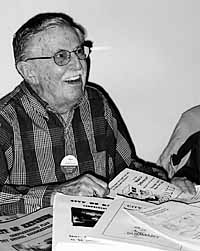Ketchum comp plan adopted
Three years and 70 meetings later
By GREG STAHL
Express Staff Writer
After more than three years of work and 70 public
meetings, a new Ketchum comprehensive plan has been adopted.
 Ketchum Mayor Guy Coles celebrates the
adoption of the city’s new comprehensive plan. In front of him are about
a dozen planning documents, past comp plans and draft comp plans that were
part of the process of adopting the new plan. Express photo by Greg
Stahl
Ketchum Mayor Guy Coles celebrates the
adoption of the city’s new comprehensive plan. In front of him are about
a dozen planning documents, past comp plans and draft comp plans that were
part of the process of adopting the new plan. Express photo by Greg
Stahl
The Ketchum City Council unanimously adopted the 2001 comp
plan Thursday at a noon meeting. Roughly a dozen residents, city staff and
city officials attended.
"I hope citizens appreciate it and appreciate the
time and work that was put into it," Ketchum resident Marilyn Nesbit
said.
Nesbit is among several Ketchum residents who attended
many of the 70 public hearings on the then-draft plan. Ketchum residents
Terry Hogue and Mickey Garcia, too, attended many of those meetings.
Councilman Maurice Charlat extended thanks to the three
residents for their perseverance.
Public involvement on the plan ebbed and flowed throughout
the three years of work. At times, Ketchum City Hall overflowed with
interested residents, and at others, Nesbit, Hogue and Garcia perused the
draft plan as the city council or Ketchum Planning and Zoning Commission
leafed through the various standards and goals set forth in it.
"We need to spend some more time on this and fight
about it some more," Garcia told the council in jest.
Toward the end of the process, public involvement trailed
off to a somewhat anticlimactic conclusion, which wasn’t surprising
considering the number of meetings and time involved with finishing the
plan, Ketchum planning administrator Lisa Horowitz said.
The comp plan planning process began at Ketchum City Hall
in February 1997. In April of the same year, the city hosted a "Make
A Difference!" meeting in which initial public input was collected.
"The most frequently mentioned issues included
traffic circulation and parking in the core and the need to make downtown
‘pedestrian-friendly,’" according to a background section in the
now-adopted plan.
The first draft plan was released in July 1998, and public
input was taken on the draft at P&Z meetings through November. During
that time, 11 meetings were held, and the prevailing public opinion was to
reformat the draft plan to more closely resemble the city’s 1983 plan.
The revised draft plan was released in February 2000. The
P&Z conducted 20 public hearings; the council and P&Z conducted 8
joint public hearings; and the council held an additional 16 public
hearings, all on the revised draft.
Last month, the city council preliminarily adopted the
plan, waited a month until Thursday’s meeting in case there were
comments on their revisions, and then finished with the lengthy process.
State law requires city councils to hold at least one
public hearing on adoption of a comprehensive plan.
"This plan will guide the growth of the next 10 to 15
years to insure that the very qualities that make Ketchum special are not
degraded by ongoing development," the plan’s introduction states.
The plan covers everything from the city’s entrance
corridors to eventual development of the River Run base of Bald Mountain.
The most hotly debated portion of the plan was the city’s
downtown core.
Among the most unpopular concepts set forth in the plan’s
original draft was one that established a downtown core, called the core
of the core, and a peripheral core that would have allowed smaller overall
building densities.
Owners of property in the hypothetical peripheral core
called "foul" at the concept, which they deemed as a taking of
their properties’ development potential. City officials listened and the
core of the core was no more.
Another controversial issue was downtown area parking.
The adopted plan states that parking will be paid for by
the user, meaning developers must provide parking on their sites, rather
than relying on city parking.
"On-street parking is primarily for short-term use,
the visiting public and secondarily for employees," states the plan.
"The private sector must address the true parking impacts and needs
of new development in the downtown area."
At Thursday’s meeting, Hogue suggested the council
include a forward in the plan that highlights the city’s past
achievements. The council agreed, and that will be the crowning addition
to the comp plan that was three years in the making.